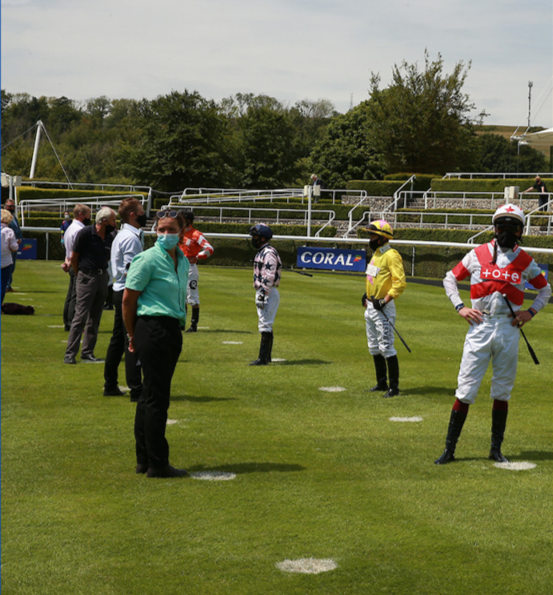
THE FOLLOWING RESUMPTION UPDATE HAS BEEN DISTRIBUTED TO RACING PARTICIPANTS TODAY
Thank you for your continued support and co-operation in following the behind closed doors protocols that have helped keep everyone safe on the racecourse since resumption.
We know that the strict protocols present additional challenges, and we are grateful for the way participants and officials have adapted quickly to the new processes over the past two months.
However, with government and public health concerns about a rise in cases and a potential ‘second wave’, it is vital that racing continues to follow the protocols so that we can resume progress towards re-introducing spectators at the earliest available opportunity through the re-scheduling of pilot events.
Key steps to keep racing on track
To support this, the BHA’s Chief Medical Adviser, Dr Jerry Hill, has asked all participants and racecourse attendees to follow these three steps to help keep you and others safe:
- Follow all the social distancing requirements when you attend racing, whether you’re in the ‘green zone’ for participants or the owners’ area.
- Do not cross from one zone to another, as this weakens the controls and could lead to many more people being quarantined if there is a positive case, as well as risking people’s health.
- Please let the BHA’s Medical Team ([email protected]) know if there’s a positive case so they can liaise with the public health authorities to manage the NHS Test & Trace process with the minimum impact. Dr Hill can offer advice to employers, which can limit the effects on their business whilst keeping staff safe.
Restrictions are easing elsewhere, why not in racing?
When racing resumed on 1 June, strict protocols were put in place for participants because social distancing could not be maintained at all times on racecourses, particularly when handling horses before, during and after races.
These measures have:
- enabled racing to restart without the need for intrusive, frequent, and expensive laboratory-testing for hundreds of participants every few days, as has happened in other sports
- helped the sport to persuade government to allow owners back on course, in a separate zone to participants
- allowed racing to continue despite a local lockdown in Leicester
- helped secure initial government support for racing to hold pilot events with spectators.
However, more recently we have seen restrictions eased in other industries, particularly around hospitality and leisure, which has led understandably to questions about why racing is not able to go further in relaxing our own restrictions.
Racing returned on 1 June in line with specific government guidance for elite sport. This guidance has been designed to support a safe, co-ordinated return to sports competition behind closed doors – and in a more controlled environment than many day-to-day activities.
This is because social distancing cannot be guaranteed when handling horses at a race-day and helps manages the risk of infection spreading through close contact. And because a race meeting – even behind closed doors – can see hundreds of people present from many different parts of the country. Taken together, these are some of the reasons why government guidelines for sport are different from those for your local pub.
Moreover, with public health officials across Britain now concerned about a rise in COVID-19 cases, and the UK Government already considering re-imposing some restrictions to manage case numbers and avoid a potential ‘second wave’, it is vital that we maintain our tight controls.
We do not want to be in a position which compromises our chances of reintroducing spectators as soon as it is safe to do so, or worse, requires us to take steps backwards towards the restrictions of owners attending or a further suspension of racing.
Avoiding possible quarantines
Public health authorities have also made it clear to the BHA that they will consider a 14-day quarantine period for all racecourse attendees in the same zone as someone who tests positive for COVID-19.
This is part of the government’s Test and Trace programme for identifying close contacts of the infected person. It could include participants, owners or members of the public, depending on where the person testing positive was situated during the race meeting.
Dr Hill has been working closely with public health authorities, both nationally and locally, to deal with a variety of issues, including preparing for the Goodwood pilot and managing a positive test for an apprentice jockey.
At present, they are reassured that racing has tight controls in place on racecourses and that this has helped reduce the number of people asked to self-isolate when carrying out the NHS’s Test and Trace process.
However, if the separation of zones breaks down – for example, because people have moved from the Green Zone for participants to the Owners’ Zone, or vice versa, people in both zones may be quarantined.
Thank you again for all your continued help and support in ensuring that the protocols work effectively to keep everyone safe on the racecourse.
